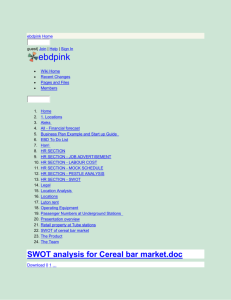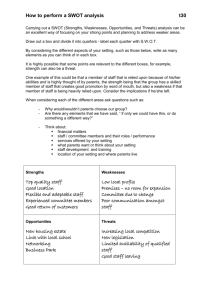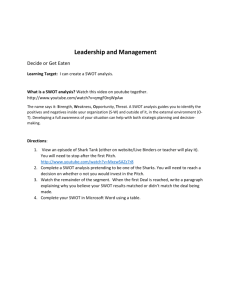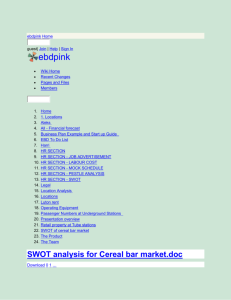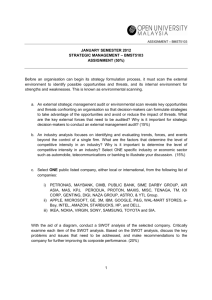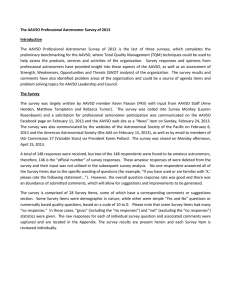SWOT Analysis – Weaknesses greater than 2%
advertisement
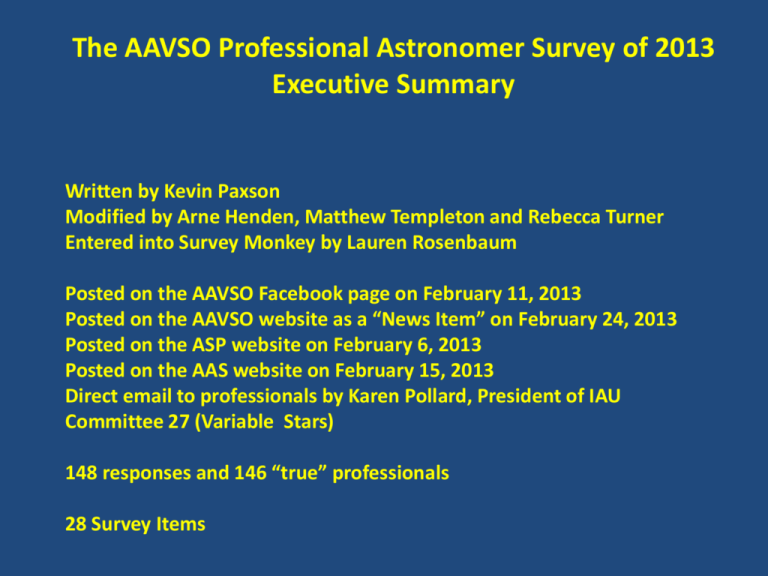
The AAVSO Professional Astronomer Survey of 2013 Executive Summary Written by Kevin Paxson Modified by Arne Henden, Matthew Templeton and Rebecca Turner Entered into Survey Monkey by Lauren Rosenbaum Posted on the AAVSO Facebook page on February 11, 2013 Posted on the AAVSO website as a “News Item” on February 24, 2013 Posted on the ASP website on February 6, 2013 Posted on the AAS website on February 15, 2013 Direct email to professionals by Karen Pollard, President of IAU Committee 27 (Variable Stars) 148 responses and 146 “true” professionals 28 Survey Items Profession (N=145 or 99.32%) • • • • • Professional astronomer – 70.06% Other – 12.74% Gov’t researcher – 9.55% Private researcher – 5.10% Industrial professional – 2.55% Country or work and residence (N=145 or 99.32%) • • • • • • USA – 74.48% Canada and UK– 3.45% each Chile and Germany – 2.74% each Australia – 2.07% France , Poland and Russia– 1.38% each Rest of the world- 0.69% each (Belgium, Bulgaria, England, Finland, Greece, Italy, Mexico, Netherlands, Norway and Ukraine) Professional description (N=145 or 99.32%) • Observer – 75.86% • Data miner – 13.79 % • Theoretician – 10.34% Past or present AAVSO Member (N=145or 99.32%) • 71.03% - No and 28.97% - Yes Main types of variable stars studied (n=121 or 82.88%) • • • • • • • • • Pulsating – 38.44% Eclipsing – 16.94% Cataclysmic – 15.96% Eruptive – 12.05% Rotating – 6.51% Other objects – 5.54% X-Ray – 2.28% Outside classification – 1.95% Intrinsic undifferentiated – 0.33% Used AAVSO observational data in the past (N=144 or 98.63%) • Yes – 71.53% • No – 28.47% Purpose of AAVSO data use (N=102 or 71.33%) • Publication – 50.96% • Other – 25.96% • Personal – 23.08% Source of non-VSP sequence or comparison star data (N=43 or 29.45%) • Literature – 16.67% • Bright Star Catalogue and Landolt Standards – 10.00% each • Personally generated, APASS, 2MASS, SDSS, SAO Catalogue, Simbad – 6.67% each • Vizer, USNO, NGS -POSS, Tycho, Planetarium program and Hubble GSC – 3.33% each Currently familiar with APASS (N=144 or 98.63%) • Yes – 39.44% • No – 60.56% Plan to use APASS in future (N=133 or 91.90%) • Yes – 78.95% • No – 21.05% Currently use AAVSO Net (N=141 or 96.58%) • Yes – 10.64% • No – 89.36% Familiar with AAVSO Outreach and Public Education (N=143 or 97.95%) • Yes – 37.06% • No – 62.94% Participation in past campaigns or collaborated with amateurs (N=146 or 100%) • Yes – 52.74% • No – 47.26% Published with amateurs as co-authors (N=143 or 97.95%) • Yes – 37.06% • No – 62.94% Published in the JAAVSO (N=142 or 97.26%) • Yes – 20.42% • No – 79.58% 10 9 8.08 8.07 8 7.87 7.86 7.74 7.42 7 6.11 6 5 4 3 2 1 0 VSP (N=51 or 34.93%) AAVSOnet (N=14 or 9.59%) AAVSO Education and Outreach (N=46 or 31.51%) AAVSO Website (N=111 or 76.03%) AAVSO Observational VSX (N=44 or 30.14%) Data (N=102 or 71.33%) JAAVSO (N=66 or 45.21%) Quality Ratings for the numerically rated Survey Items. SWOT Analysis – Strengths (N=94 or 64.38% and 228 total comments) Strengths Rank Count Net % 1 Data, the archive, observations and accessibility 87 37.50 2 Amateur members and observers 32 13.79 3 Collaboration, campaigns and amateurs in research 20 8.62 4 The organization, mission, enthusiasm and sense of community 20 8.62 5 Public Education, Outreach, member training, Citizen science 19 8.19 6 Online tools - LGC, VSP, VSX and others 13 5.60 7 Online publications, resources, information and materials 9 3.88 8 APASS 8 3.45 9 AAVSOnet and robotic systems 5 2.16 10 Tradition, name recognition and longevity 5 2.16 11 Administration, staff and volunteers 4 1.72 12 Website and infrastructure 3 1.29 13 Help, assistance, motivation and focus 3 1.29 14 News events and announcements 1 0.43 15 No specific comments 3 1.29 232 100.00 Totals SWOT Analysis – Weaknesses greater than 2% (N=62 or 42.47% and 86 total responses) Rank Weaknesses Count Net % 1 Poor marketing of AAVSO resources and capabilities with other professional organizations 11 12.79 2 Poor data quality and accuracy (visual and CCD) 9 10.47 3 Poor age and gender demographics 6 6.98 4 Poor funding 5 5.81 5 Abundance of visual data 4 4.65 6 Uneven coverage of variables 4 4.65 7 Poor AAVSO / amateur reputation by professional astronomers 3 3.49 8 Perception as US based, not international 3 3.49 9 Weak link / service to members and observers 2 2.33 10 Limited data / observers in southern hemisphere 2 2.33 11 Slow server 2 2.33 12 Data extraction issues 2 2.33 13 Observers go for "numbers and awards" versus doing good science 2 2.33 14 Difficulty in organizing amateurs for projects 2 2.33 SWOT Analysis – Opportunities greater than 1% (N=59 or 40.41% and 102 total responses) Rank Opportunities Count Net % 1 Professional co-operation, collaboration and campaigns 12 11.88 2 More amateurs with CCD's and reduction software 7 6.93 3 Outreach and Education for new observers and members 7 6.93 4 Increased coverage, long term monitoring and time domain observations of variable stars 7 6.93 5 Spectroscopy 6 5.94 6 APASS 6 5.94 7 Continued expansion and more photometric data 4 3.96 8 More all sky bright star photometry 3 2.97 9 Lobby and increase variable star efforts in the community 2 1.98 10 AAVSOnet and /or remote observing 2 1.98 11 DSLR photometry 2 1.98 12 Outreach and Education 2 1.98 13 Follow ups for new discoveries and transients 2 1.98 14 Robotic telescopes 2 1.98 15 Automated surveys 2 1.98 16 New equipment and technology 2 1.98 SWOT Analysis – Threats greater than 2% (N=56 or 38.56% and 88 total responses) Rank Threats Count Net % 1 Funding and cuts in grants 18 20.93 2 All sky surveys 16 18.60 3 Light pollution 7 8.14 4 Age demographic 6 6.98 5 Variable star subject matter 3 3.49 6 Observer interest, motivation and relevancy 2 2.33 Suggestions to better serve the professional community (N=40 or 27.40%) Rank Suggestions for Improvement Count Net % 1 More PR on AAVSO resources and capability at professional meetings 8 20.00 2 Doing fine, serving professional community well and keep up good work 5 12.50 3 Better relationships with professional community through personal contact and emails 4 10.00 4 Better data quality (CCD and visual) 2 5.00 5 Merge data from professional and amateur sources from around the world 2 5.00 6 Better means for collaboration and campaigns 2 5.00 7 Make variable star astronomy more exciting and significant 2 5.00 8 Address and fix APASS issues 1 2.50 9 Increase member education for research and quality science 1 2.50 10 Focus on a limited number of bright stars not covered by very large surveys 1 2.50 11 Get APASS magnitudes deeper 1 2.50 12 “Fainter than” alerts 1 2.50 13 Get members and observers to do IR photometry and high resolution spectroscopy 1 2.50 14 Expand AAVSOnet for time series work 1 2.50 15 Continue strong leadership for professional co-operation 1 2.50 16 Sponsor regional meetings of VS research 1 2.50 17 Make APASS light curves available 1 2.50 18 Make APASS queries easier 1 2.50 19 Do spectroscopy correctly to ensure high quality 1 2.50 20 Find better ways to highlight news and discoveries to pros and public 1 2.50 21 No specific suggestions 2 5.00 Totals 40 100.00 Leave personal email address for feedback. • • 41 individuals responded. AAVSO hopefully will send thank you letters and copies of the Executive Summary. Professional Astronomer Survey Take Away – Six Problem Areas for Improvement Increased public relations for AAVSO resources and capability at professional meetings • • • • Ranked first on the Improvement suggestions list. The highest ranked Weakness on the SWOT analysis. Knowledge of AAVSO and capabilities commonly unknown. Suggestions included increased presence, presentations and/or booths at professional meetings. Poor data quality/abundance of visual data • Poor data quality ranked second on the Weakness of the SWOT analysis. • Poor data quality ranked fourth on the Improvement suggestion list. • Abundance of visual data ranked fifth on the Weakness of the SWOT analysis. • Visual and CCD data quality needs to be improved. • There is too great of an abundance of visual data relative to CCD. More and improved networking with the professional community • Ranked third on the Improvements suggestion list. • Suggestions included more personal contact, creating professional email lists and sponsoring an annual Variable Star Conference for professionals. Quality of the JAAVSO • Lowest quality score (7 out of 7) of the numerically based Survey Items. • Suggestions included an improved and standardized page size and format, inclusion of figures within the text and improved technical content. • Form a committee to improve the quality and content of the JAAVSO? Better means for collaboration and campaigns • Ranked first on the Opportunity list of the SWOT analysis. • Ranked sixth on the Improvement suggestions list. • Some astronomers found the process for initiating campaigns and collaboration lacking, difficult and/or poorly defined. Increased coverage/less uneven coverage of variable stars • Increased coverage ranked fourth on the Opportunity list of the SWOT analysis. • Uneven coverage of certain variable stars ranked sixth on the Weakness list of the SWOT analysis. • Data gaps and cadence were seen as problem areas. • Many desired better coverage (LT monitoring and time domain) of more variables of all types. Finis. Kevin B. Paxson – PKV May, 2013

